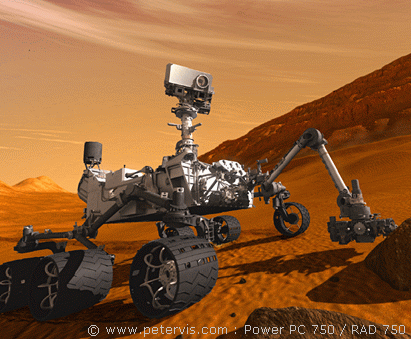Mars Rover Curiosity

This NASA Rover is an artificial intelligence (AI) life form capable of independent thinking made possible by 2.5 million lines of programming and miles of wiring; it is so intelligent that currently it is the only intelligent life on Mars.
Since a radio signal can take between 4.5-minutes to 21-minutes to travel to Mars, real-time remote control of the rover is not possible. Due to this restriction, algorithms provide autonomous operation whilst waiting for instructions from Earth. Some of its heuristics includes self-preservation routines, such as avoiding cliffs, pits, and large rocks.
The AI algorithms use information from on-board sensors to make independent decisions. The weather can change quickly, and violent storms can damage the rover. Consequently, it will find a safe place, to shield itself from harm when this happens. During this time, it switches off its subsystems to conserve power. When the RAD750 processor is in sleep mode, the subsystems continue to operate sensing the temperature, weather, and environmental variables. At the first sign of any trouble, they are capable of waking the robot to execute self-preservation algorithms.
A digital heartbeat transmitted back to Earth provides Curiosity’s health status at all times. Each beat contains digital data regarding the condition of its vital subsystems. This information lets the Engineers know that Curiosity is still "alive". Curiosity will officially die in 15 years time when the nuclear battery stops producing enough power, and the heartbeat will stop.
Based on redundant processor pair architecture, the computer system is highly reliable. If one processor fails, the other kicks-in and takes over. Each processor has an independent ROM and 250 MB of radiation hardened DRAM memory core. This is just enough for the full range of tasks it is expected to carry out in this mission.
Curiosity does not use a hard drive because modern hard disks rely on the floating head principle that requires air. The air on Mars is 100 times thinner than on Earth therefore a hard disk cannot operate. Instead, the programming, which is around 2.5-million lines of C++ code, is stored on a 2 GB flash ROM chip. There are two copies of the software, one held in a compressed file, so that if there were to be a memory corruption the system can repair itself because it would be too costly to send an IT Technician to Mars to reinstall the operating system.
I wonder what would happen if it found life on Mars? Does Curiosity have the programming for first contact protocol? If the rover decides to drill a hole through the Martian to obtain a rock sample, then it could spell disaster, and start a war of the worlds. :-)
This Article Continues...
RAD750 ProcessorPowerPC 750 Processor
Mars Rover Curiosity
Single Board Computer (SBC)
RAD750 Processor Architecture
Radiation Hardened
Mars Rover Power Supply